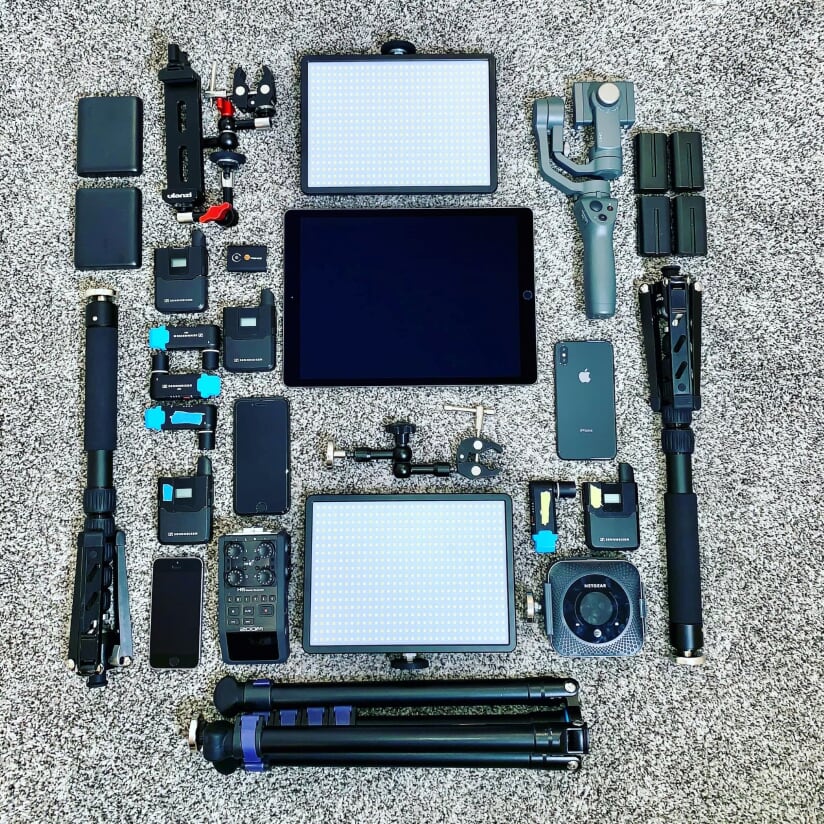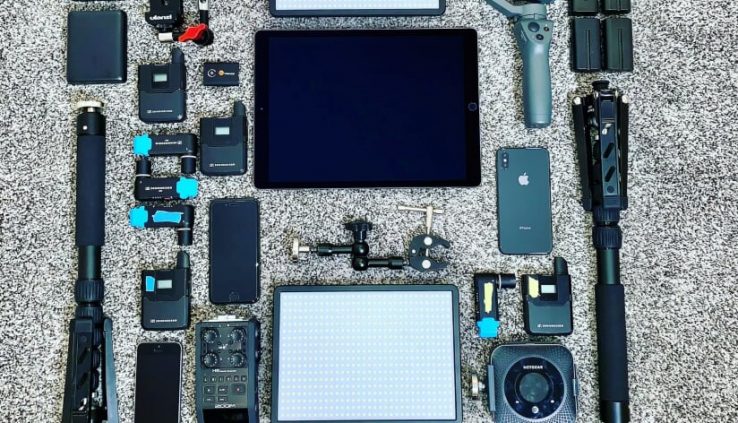7 Rules for Mobile Multicam Success
By Adam Noyes
Streamingmedia.com recently posted a great article featuring seven tips for creating professional productions with your cell phone or mobile device! With mobile phone cameras getting better and better, and devices like the SlingStudio and the NewTek’s TriCaster, among others, accepting smart phone feeds directly into their interfaces, producing with your smart phone is now easier than ever.
We’re going to take a look at some of the finer points of that article below.

Rule #1: Bring Your Own Good Wi-Fi
Wi-Fi is the backbone of connecting cameras to a controller to enable the director to see all the cameras live and to be able to share an internet connection. For the vast majority of mobile multicam, Wi-Fi replaces all the wires. In certain RF-hostile situations, like conventions and big sporting events, you may actually have to run wires to each device to carry the video signal. But for at least 95% of the time, Wi-Fi replaces wires.
Using an iPad’s built-in Wi-Fi may work, in some cases, with one external camera or two. But it is a real compromise compared to using a good, high-end wireless router. Currently, good wireless routers start at about $150 each. Also consider mesh Wi-Fi systems. Google Wi-Fi is one such solution, but there are many. A single mesh router/wireless access point (WAP) may not have the same Wi-Fi range as a single high-end wireless router, but mesh systems let you add a second, third, and fourth WAP to create a blanket of coverage. Some look like a hockey puck, but they come in a variety of shapes and sizes.
What these “pucks” do is communicate with each other, like miniature cell towers, and blanket the area in wireless coverage, stretching the range beyond a single WAP. This is especially handy for outdoor events covering a large field or in a conference area spanning multiple rooms. Some are dual-band, meaning they operate on 2.4 GHz and 5 GHz. Some are tri-band and offer a second 5-GHz channel for sending data between the pucks, leaving the primary 5-GHz channel dedicated to communicating with handsets. 5 GHz has more bandwidth and more channels and is generally preferred over 2.4 GHz for the camera connections.
Elevating your Wi-Fi network above the crowd is also essential. At home, a Wi-Fi WAP on a table is fine, because there are just a few people. But at a public event, with tens or hundreds of people, the human body blocks and absorbs Wi-Fi. Your devices need a clear line of sight to every WAP you use, and that means getting them high into the air.
When getting started, it’s easy to expect to use a facility’s Wi-Fi or just set up a hotspot on a handset or iPad. But time and again, this leads to frustration. Dropped frames. The iPad can’t see the cameras. Poor upload speed. Failed streams. All the time. So Rule #1 for everyone starting out: You can only count on your own good WiFi, that you use every time, with capabilities you know.
If you are going to be given an Ethernet line for upload, then you can plug that into your router. If you are providing your own hotspot for the internet connection, you can plug that into your router. Whatever your internet connection is, it connects into your good Wi-Fi system, which is solely for the interconnect between your cameras. Don’t share your Wi-Fi network with other people. You will only be able to reliably count on your own good Wi-Fi that you use every time and whose capabilities you know.
This is not to say there won’t be challenges. There will be times when the Wi-Fi signal has difficulty getting data through. You can bring the best Wi-Fi router, but it may have to compete with wireless HDMI video transmitters, wireless communications systems, and more, which all use the same 5-GHz bands. Those other systems completely ignore—and stomp all over—Wi-Fi signals. For those times and situations, you may have to run wires to each device, as I have had to when doing my mobile multicam live production at the NAB Show. Wi-Fi doesn’t even work a few feet away. There’s just too much hostile RF for video to reliably make it over Wi-Fi.
Rule #2: Don’t Trust the House
We’ve already established that you never use a facility’s existing Wi-Fi. But it’s convenient when they tell you they have microphones and “house audio.” They may even be able to provide a feed for you to use. But the feed might be too loud or too quiet, so you should always bring your own mixer to be able to handle any level audio the house will give you (Figure 3, below). Barrel adapters, converters, and isolating transformers are great accessories to bring along as well.

Figure 3. Always bring your own mixer, such as the compact one shown here.
Also, be sure to have some microphones at the ready. I’ve lost count of how many times a critical part of an event happens in a way in which there’s no microphone. Whether it’s crowd applause or laughter, a question from the audience, or a case in which a microphone gives out and a person just continues by speaking louder to the available audience, lots of circumstances can conspire to render essential audio inaudible to your camera or primary audio capture device. This is why I always add an “ambient” mic—a microphone aimed into the room—to capture this audio, in addition to the house feed.
Mobile producers should also bring along an uninterruptible power supply (UPS). It can be catastrophic to have your whole setup plugged into the wall, only to have someone mistakenly move your plug or bump into it or to have that outlet lose power when some-thing in another room overloads and trips the circuit breaker. Make sure you can continue running, for at least a few minutes, while you figure out why you lost power. Often, it’s a quick fix, and a UPS saves everything from going black.
You’ll also need backup for house internet. Several times, I’ve been handed a cable and told I have 10Mbps or 20Mbps up, when, in reality, the actual data rate fluctuated, and even a 5Mbps stream had trouble. You could use an LTE cellphone or hotspot in a pinch—but only if you’ve set it up in advance and have made sure you have all the pieces needed to swap it out for the landline.
At big events with a huge audience, you’d be competing for the same cellular resources as every other cellphone in the audience. Dedicated tools can enable you to bond multiple internet connections together to send the video stream to the internet. This way, the failure of any single connection will not break your stream.
Because your packets of video take different routes on the different services, bonding also requires a service to reassemble the packets of data in the right order before sending them to a content delivery network. Both the bonding device and the cloud service that reassembles the stream add processes and costs that you need to factor in before showtime.
streamingmedia.com
To check out the full article, and the remaining four tips, click here.

